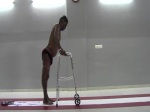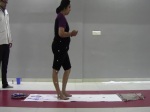NEURO PHYSIOTHERAPY
This site is about the discussion about the neuro physiotherapy management, case studies, issue/problem during planning of neuro rehabilitation
About Me

- GAJANAN BHALERAO
- DR. GAJANAN BHALERAO (PT) MPTh Neuro, MIACP, MIFNR, MIAP SENIOR LECTURE Masters in physiotherapy, Neurosciences Sancheti Institute College of physiotherapy, Shivajinagar, Pune. Mobile : 9822623701 Email:Gajanan_bhalerao@yahoo.com, gajanan.neurophysio@gmail.com PUBLICATIONS:- Comparison of Motor Relearning program versus Bobath Approach in acute stroke rehabilitation: Journal of Orthopedics And Rehabilitation, India, 2011 RESEARCH PAPER PRESENTATIONS & AWARDS:- INTERNATIONAL 1.Winner Of Young Presenters Scholarship From Epilepsy Foundation India, in the conference of“International congress on neurology and rehabilitation Goa April 2010”, STATE LEVEL: 1. Winner of best paper award in engeering and technology category In Avishkar 201o of Maharashtra university of health sciences (MUHS), Nashik India. 2.WINNER OF BEST PAPER FOR scientific paper presentation in AVISHKAR 2010 of Maharashtra University of Health Sciences (MUHS), AURANGABAD, India. REESOURCE PERSON/COURSE INSTRUCTOR:- I have conducted Conducted workshop on 1. 2D & 3D Gait Analysis and its Management 2. MOTOR RELEARNING PROGRAM- for stroke rehab 3.Spinal Cord Injury Rehabilitation
Tuesday, 30 June 2020
Which specialty Physiotherapy clinical practice is better for business d...
Which specialty to choose for clinical practice? Musculoskeletal, Neuro , Cardio respi, Paediatrics, women's health, Geriatric or sports & fitness.
Which specialty Physiotherapy clinical practice is better for business development?
Which specialty has more scope of business development and scaling?
Which specialty has more numbers of Patients /customers ?
Chapter
0:00 Introduction to topic
4:30 MPT specialty is not equal to clinical specialty
Patients /Customer Density
7:30 Patients /Customer Density in each specialty
8:30 MPT seats parentage of each specialty in Maharashtra
10:00 Frequency of need of search for new cases in each specialty
12:00 Average Period of treatment in each specialty
13:25 NC , OC number and follow up period of treatment
16:00 Scope Of Financial Funding in each specialty
22:20 Which specialty has more scope of business development and scaling?
28:00 Overall rating of each specialty
30:00 Which specialty to choose for clinical business practice ?
31:00 Questions and answers
Wednesday, 17 June 2020
HOW TO CONVERT HOME VISIT PRACTICE INTO PROFESSIONAL BUSINESS?
Hi everyone
Thanks for registration for yesterday " HOW TO CONVERT YOUR PHYSIOTHERAPY HOME VISIT PRACTICE IN PROFESSIONAL BUSINESS MODEL?"
Those who missed yesterday's meeting can watch today on YouTube live.
TODAY EVENING YouTube live 9:00 pm Today 17/06/2020.
Monday, 15 June 2020
HOW TO CONVERT YOUR PHYSIOTHERAPY HOME VISIT PRACTICE IN PROFESSIONAL BU...
GB school of Physiopreneurship presents webinar on
" HOW TO CONVERT YOUR PHYSIOTHERAPY HOME VISIT PRACTICE IN PROFESSIONAL BUSINESS MODEL?"
Scheduled for Tuesday Jun 16, 2020 9:00 Pm YouTube live and google meet.
Key features of lecture
Why corporate company successful in home care business?
Why cant we physio develop business model for ourselves?
how to do organised structure of practice?
How to do structured appointment, documentation billing and accounting ?
Fundamental rules to follow to be professional Physio at home care
HOW TO CONVERT YOUR PHYSIOTHERAPY HOME VISIT PRACTICE IN PROFESSIONAL BU...
GB school of Physiopreneurship presents webinar on
" HOW TO CONVERT YOUR PHYSIOTHERAPY HOME VISIT PRACTICE IN PROFESSIONAL BUSINESS MODEL?"
Scheduled for Tuesday Jun 16, 2020 9:00 Pm YouTube live and google meet.
Key features of lecture
Why corporate company successful in home care business?
Why cant we physio develop business model for ourselves?
how to do organised structure of practice?
How to do structured appointment, documentation billing and accounting ?
Fundamental rules to follow to be professional Physio at home care
Wednesday, 10 June 2020
Monday, 8 June 2020
Friday, 5 June 2020
CAUSES AND MANAGEMENT OF CIRCUMDUCTION GAIT IN HEMIPLEGIC
Join and share with friends Lecture on
“CAUSES AND MANAGEMENT OF CIRCUMDUCTION GAIT IN HEMIPLEGIC"
Where is the cause? Hip, knee or ankle?
What is best therapeutic management?
What is effective, NMES or FES?
Which splint is more effective?
Gait training?
6/06/2020 Saturday 8:00 pm IST YouTube live
https://youtu.be/t-d3Su5Orhc
Tuesday, 26 May 2020
Sunday, 10 March 2013
NDTA approved NDT ADULT CERTIFICATE COURSE IN PUNE, INDIA
NDT/Bobath Certificate Course in the Management and Treatment of Adults with Hemiplegia
Sancheti Institute College of Physiotherapy, Sancheti Health Academy, Shivajinagar, Pune, Maharashtra, India
This is the first time NDTA is conducting a ADULT NDT course in INDIA. We want maximum people to benefit from this course. But there a seats limit of 30 only. Everyone will need to apply for the course and the NDTA/course instructors will select the delegates for the course depending on their experience and accreditation in the field of adult neuro.
Course Dates:
27-01-2014 - 14-02-2014
It will be 5 days/week for three weeks. Saturday & Sunday off.
Course Number: 14A101
Course Status: Approved
Location: Sancheti Institute College of Physiotherapy, Sancheti Health Academy
Thube Park 11/12
Shivajinagar, Pune, Maharashtra, India, 41105
Course Instructors:
Cathy Hazzard, B.Sc, MBA, PT, C/NDT CI
Nicky V. Schmidt, PT, C/NDT CI
Cathy Hazzard, B. Sc. P.T., MBA is a Physiotherapist with over 25 years experience working with adults with varied neurological diagnoses. Her clinical background also includes experience and continuing education courses in manual therapy and orthopedics. She obtained an MBA in 1993 while continuing to work as a PT. She has been an NDTA™ Coordinator Instructor in Adult Hemiplegia since 1998 and has taught introductory, certificate and advanced level NDT courses extensively throughout North America (Canada, United States, and Mexico) and internationally in such countries as Ireland, Hong Kong, Singapore, Estonia, Colombia, and Peru. Cathy practiced in Calgary, Alberta, Canada for over 20 years in the acute, rehabilitation and outpatient phases of care. She is now working in private practice and Home Health on Vancouver Island, British Columbia. Cathy served as the Chair of the NDTA™’s Instructor Group from 2002 – 2005 and a member of the Board of Directors of NDTA™ from 2003 – 2007.
Nicky Schmidt, PT, received her bachelor’s of science degree in Physical Therapy from Louisiana State University Medical Center in 1978. She is NDT trained in both pediatrics and adult hemiplegia and has been an active NDTA Coordinator-Instructor since 1985. Ms. Schmidt has taught NDTA introductory, basic, and advanced courses throughout the United States and Canada for 28 years. During her 33 years of clinical practice she has worked as a clinical neuro specialist in a broad spectrum of healthcare settings including acute care hospitals, short-term rehabilitation, outpatient rehabilitation clinics, home health and private practice. Nicky was an Associate Clinical Professor at LSU Medical Center in the 1980’s, is a past member of the NDTA Curriculum Committee, and past board member and Instructor Group Chair of NDTA. Currently, Ms. Schmidt is in private practice in the New Orleans area where she specializes in consultation for and treatment of adult and pediatric clients with diagnoses of stroke, brain injury and cerebral palsy.
Course Contact:
Dr. Gajanan Bhalerao
Phone: 9198 22623701
Fax: 9120 25539494
gajanan_bhalerao@yahoo.com
Website
http://www.ndta.org/course_list.php?type=AH#course283
The course details about the fee structure, eligibility, and course details will be published soon on facebook page.
Those who are interested please accept the invitation or show your interest so i will get your contact details. Then i can send you the course details as soon as it is finalized.
Thanks for showing interest.
Monday, 12 November 2012
Causes and management of hyperextension of knee in hemiplegic and Paraplegic
Genu recurvatum is a deformity in the knee joint, so that the knee bends backwards. In this deformity, excessive extension occurs in the tibiofemoral joint. Genu recurvatum is also called knee hyperextension and back knee. This deformity is more common in women and people with familial ligamentous laxity.
Normal range of motion (ROM) of the knee joint is from 0 to 135 degrees in an adult. Full knee extension should be no more than 10 degrees. In genu recurvatum (back knee), normal extension is increased. The development of genu recurvatum, may lead to knee pain and knee osteoarthritis.
Hemiplegic patient have a common gait deviation during their gait training is hyper-extension of knee or genu recurvatum.
Cause of genu recurvatum are
1. Weakness of plantar flexors:
2. Flail foot i.e. polio, cerebral palsy etc
3. Tightness of plantar flexors (TA tendon)
Becouse of above factors patient shows a poor loading responce in gait.
In normals loading responce ankle goes from 10 degree of plantar flexon to 10 degree of relative dorsiflexion and knee in 10-20 degree of lexion. There is anterior translation of tibia over the fixed foot.
This anterior translation of tibia over the fied foot is affected due to TA tigthness.
In weakness of plantar flexors & flail foot if tibia moves over the fixed foot and goes in to relative dorsiflexion then this may lead to buckling of knee and lead to poor stability during loading responce to mid stance. to avoid this patient does the compansotory movement of, avoiding the anterior translation of tibia and forward lurching gait, with locking of knee. frequent use of this pattern of locking mechanism of knee during walk leads to hyperextension of knee.
1. in case of weakness of platar flexors , . flail foot & weakness in whole limb use HIGH AFO. That is the posterior strap of the AFO is hiogh enough up the lower margine of popliteal fossa.this long leverage prevents it from going backward.

2.But this will not work in patients who walk with forward lurch posture or those who take bigger step length of opposite unaffected leg.the solution for this is very simple reduce the step length of opposite leg and allow him to step by the affected leg instead of going ahead. this will pull back the line of gravity which was falling forward to knee and reduce hyper extension.
3. In the patients having sever hyeperextension and can't be corrected by all these measures then the last solution is use KAFO for walking.
4. knee surgery are not successful for preventing hyperextesnion.
5. In TA tightness -do stretching but the effect doesn't last longer in the functional activity of walking. so we should give functional stretching. for this use modified AFO{FRO} : shift the calf bad of AFO anteriorly this produces good three point pressure phenomenon and helps in stretching the TA in functional activity of walking and helps in reducing recurvatum.
6. In cases Poor trunk control and imbalance or low postural tone ( Down & hypotonic CP. wok on postural tone , trunk control in addition give AFO & walker with forearm support this reduces the forward flexion of trunk.
References
1. WHO | Stroke, Cerebrovascular accident [Internet]. [cited 2010 Aug 3]; Available from: http://www.who.int/topics/cerebrovascular accident/en
2. Tapas kumar banerjee et al. Epidemiology of stroke in India. Journal of Neurology Asia.2006;11:1-4.
3. Edward R. Laskowski, M.D. Hyperextended knee: Cause of serious injury http://www.mayoclinic.com/health/hyperextended-knee/AN00283
4. Jennifer Kirkman, Yahoo! Contributor Network. Hyperextended Knee-Causes, Symptoms, Diagnosis, and Treatments
Jennifer Kirkman, Yahoo! Contributor Network. Hyperextended Knee-Causes, Symptoms, Diagnosis, and Treatments
5. what is genu recurvatum? http://www.wisegeek.com/what-is-genu-recurvatum.htm.
6. Allison Cooper et al. The Relationship of Lower Limb Muscle Strength and Knee Joint hyperextension during the Stance Phase of Gait in Hemiparetic Stroke Patients. Journal of Physiotherapy research international.2011;(17)1.
7. Lucarli P et al. Alteration of load response mechanism of knee joint during hemiparetic gait following stroke. Journal of clinics.2007;22:813-820.
8. Susan Richardson. Assessing knee hyperextension in patients after stroke: comparing clinical observation and Siliconcoach software. International Journal of Therapy and Rehabilitation, Vol. 19, Iss. 3, 07 Mar 2012, pp 163 - 168. http://www.ijtr.co.uk/cgi-bin/go.pl/library/article.cgi?uid=90240;article=IJTR_19_3_163_168.
9. Bleyenheuft et al. Treatment of genu recurvatum in hemiparetic adult patients: A systematic literature review. Journal annals of physical and rehabilitation medicine.2010;53(3):189-199.
10. Rehabilitation, Treatment and Orthotic Management of the Stroke Patient. http://www.healio.com/orthotics-prosthetics/orthotics/news/online/%7BBDC02BFE-6C76-42E6-8457-462C3F6EC0B7%7D/Rehabilitation-Treatment-and-Orthotic-Management-of-the-Stroke-Patient
Subscribe to:
Comments (Atom)






